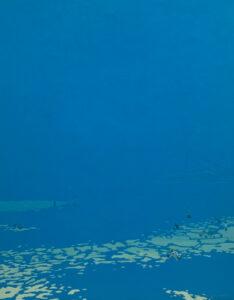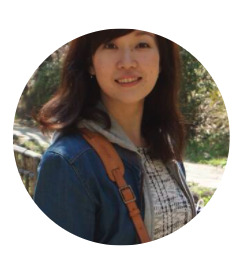Chiho Yonemushi is a Japanese painter who paints images that seem to haze in her vision. Her style stems from her experience of a whiteout. She describes her experience as follows.
"I couldn't see a meter ahead, everything I could see was blank. I felt as if I had lost my sense of direction. I don't even know if I'm standing straight. It's as if I've been thrown out into outer space."
In reality, there is gravity, and we should be able to recognize up and down. However, the whiteout confused my grasp of space through visual information, and lost her sense of direction. You may feel as if you are floating in a blank space, or She felt as if she was floating in a white space, or as if she had fallen into a milk-colored sea. It was a life-threatening and terrifying experience for her. It was not only a terrifying experience, but also an unrecognizable, infinitely expanding space. It must have been an experience of unrecognizable and infinitely expanding space, of the concept of space as a vague expanse without up and down, left and right. This experience made the various boundaries of the world ambiguous for her. In her works, she depicts various landscapes, such as cities, forests, and oceans. The nearer the scene, the clearer it is, and the more distant it becomes, the more hazy it becomes. In the city, the buildings that seem to be spreading out in the distance become hazy. In the forest, the depth of the forest itself is lost, and in the ocean, the horizon is lost. In the city and the forest, the size and breadth of the space is ambiguous. In the seascape, the horizon line, the visual boundary between sky and sea, has become ambiguous. 
(The gap between the sky and the sea,H 72.7cm x W 91cm x D 2.7cm,Chiho Yonemushi, 2019)
See more detail
In contrast to the impossibility of grasping space in forests and cities, seascapes, in terms of the loss of the concept of boundary created by the illusion of the horizon, rather expose the fiction of the superficial The seascape, on the other hand, in terms of the loss of the concept of boundary created by the illusion of the horizon, rather exposes the fiction of the superficial world that we perceive visually and invites us to the reality of the world that exists behind it. In this sense, Yonemushi's works are an opportunity to shake our existing perceptions and reconstruct the way we see the world every day through everyday motifs. Regarding the motif of seascape, we cannot avoid Hiroshi Sugimoto's "Seascape" series. Sugimoto explains about this series on his website as follows.
"Water and air, this all-too-common presence. This existence, which is so commonplace that we hardly pay attention to it, is the guarantee of our existence. The beginning of the world began with the myth that water and air were given to us. The phenomenon of life was created by water and air, plus light. The only way to explain how this happened is to say that there was a god of chance. We can only say that there is a god of coincidence. In our solar system, there are planets that maintain water and air. It also happens to be at a reasonable distance from the sun. It just happened to be at the right temperature to support life. If there is such a planet. But, as far as I can see, there are no similar planets in the universe. However, as far as I can see, there is no other planet like it. This grateful and mysterious water and air is in front of us as the ocean. Whenever I look at the ocean, I feel a sense of peace, as if I am returning to my ancestors. And so I set out on my journey to see the sea."
As mentioned above, in this series of works, he uses In this series of works, as mentioned above, he attempts to capture the fundamental elements of life: air and water. The detailed expressions of the waves and the atmosphere of the air, as if he had captured the particles in the air, are the result of this attempt. In contrast to the obscurity of Yonemushi's works, the atmosphere of the air is In contrast to the obscurity of Yonemushi's works, they are similar in their attempt to capture and express the truth of the world. Sugimoto also uses the so-called silver halide printing method to create his works. In this method, the image projected on film is printed on photographic paper in a darkroom. This is a printing method that uses the oxidation/reduction of silver particles, and it is possible to see the unique graininess in the photograph. In other words, this image is a collection of particles. In contrast, gofun, which is used by rice steamers, is made from shells, and rock paint, as its name suggests, is made from crushed minerals. They are also both particles. And in her case In her case, the structure of these particles covering the screen (i.e., the field of vision) is the result of the artist's own experience of whiteout. In her case, the structure of these particles covering the screen (i.e., the field of vision) overlaps with the whiteout experienced by the artist herself.

(Between the Sky and the Sea,H 41cm x W 31.8cm x D 2cm,Chiho Yonemushi,2021)
See more detail
Godfried Leibniz, a German philosopher of the 17th and 18th centuries, believed that this world is Godfried Leibniz, a German philosopher of the 17th and 18th centuries, advocated that the world is composed of countless monads. According to his theory, these monads are not identical and have no influence on each other. In his theory, these monons are not identical and have no influence on each other, but all things in the world change when they move in a harmonious manner. It is clear from the development of modern science that his reasoning was wrong. At the same time, however, science has shown that the world is composed of very small particles, such as atoms and subatomic particles. But at the same time, it is also true that in science, the world is composed of very small particles such as atoms and subatomic particles. But let's not forget that these perceptions and theories are also constantly changing. If the world is a collection of countless particles, then If the world is a collection of countless particles, then Sugimoto's seascapes and Yonezumi's hazy images If the world is a collection of countless particles, then Sugimoto's seascapes and Yoneshige's hazy images can be said to be an act of trying to capture a reality that cannot be captured visually. There is still a fictional boundary in front of our eyes, like a horizon line. On the other hand, the physical structure of the real world, which is nothing more than the sum of the activities of particles that cannot be perceived visually, can be seen through our eyes. On the other hand, in the face of the physical structure of the real world, where the world is nothing but the sum of the activities of particles that cannot be perceived by sight, how can we once again On the other hand, in the face of the physical structure of the real world, where the world is nothing but the sum of particles that cannot be perceived visually, how can we once again grasp the outline of the world?
CHIHO YONEMUSHI

CONCEPT
Previously, I encountered a snowstorm at a ski resort in Hokkaido, and that time I experienced whiteout.
One meter ahead is invisible, and all the things I can see are completely blank, make me feel I lost the sense of direction. I even don't know am I standing straight or not.
It seems I was been thrown into outer space.
I was really scared, but I'm fascinated by the endlessly large space since that moment.
Based on the feeling at that time, I try to create the work piece with the motif of my familiar landscape.
The horizon is not drawn in my work in stead of a large space on the scenes.
And I do not want to bias the picture, so I choose various colors and motifs to create.
The paints used are acrylic paints, Japanese paints, etc. and I support uses Japanese paper.
BIOGRAPHY
1984 Born in Saitama Prefecture
2006 Graduated from Meisei University, Department of Japanese Art and Design, majoring in Japanese Painting
2008 Graduated from Hayami Geijutsu Gakuen, Japanese Painting School
2018 The 45th Spring Tokyo Soga-kai Exhibition, Honorable Mention
The 45th Soga Exhibition, Honorable Mention
2019 FACE Exhibition, Selected, Sompo Japan Nipponkoa Art Award Exhibition
Selected, 46th Spring Soga-kai Exhibition, Tokyo
The 46th Soga Exhibition, Honorable Mention
 The work introduced here is handled by TRiCERA.
The work introduced here is handled by TRiCERA.